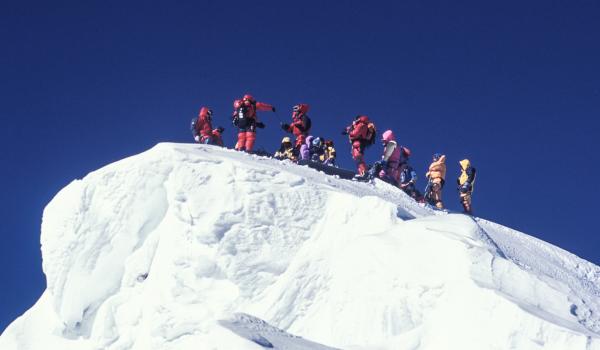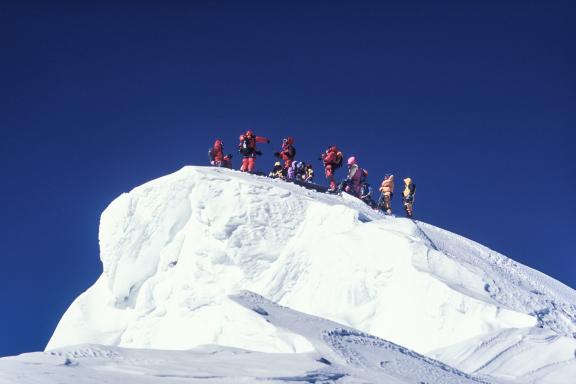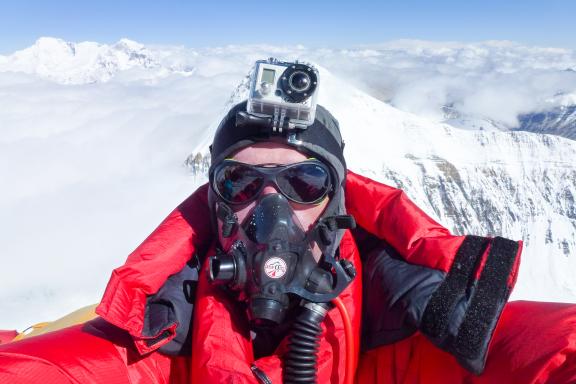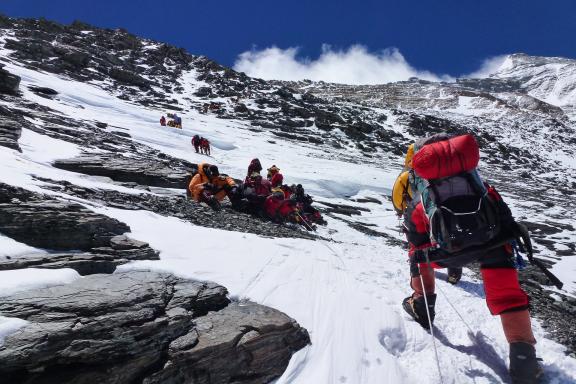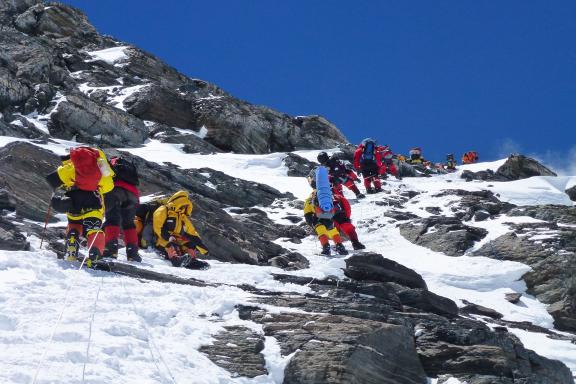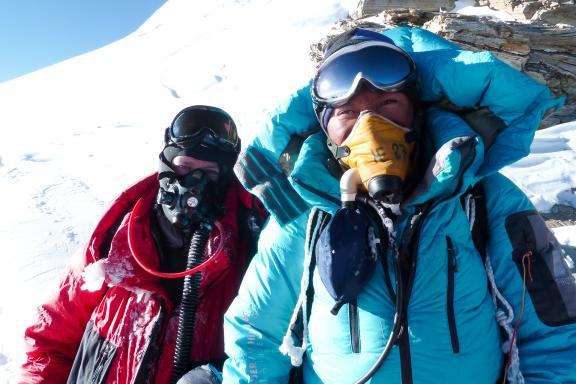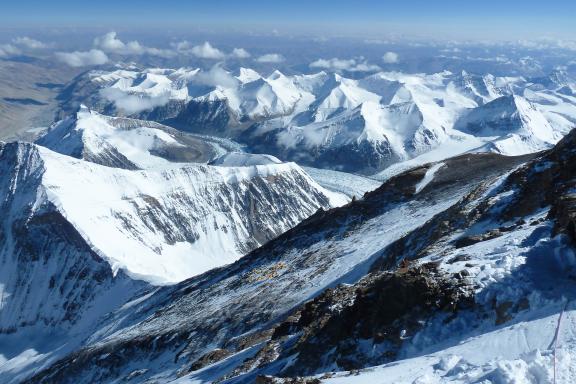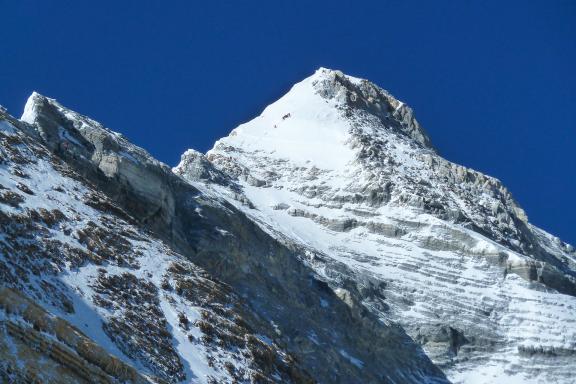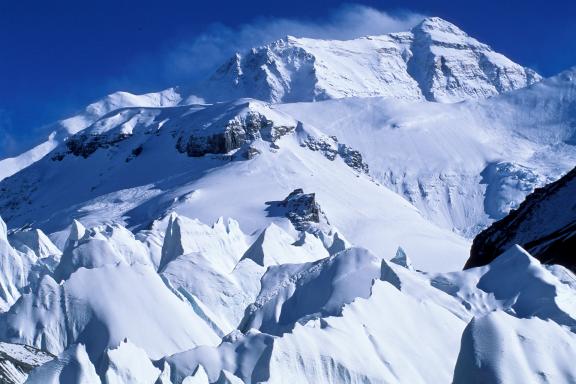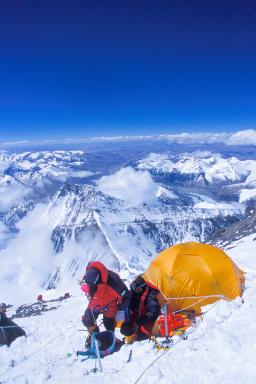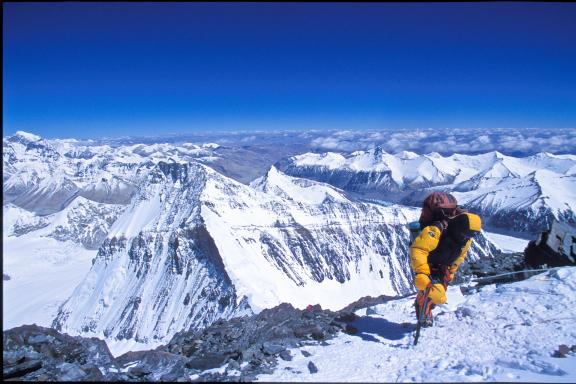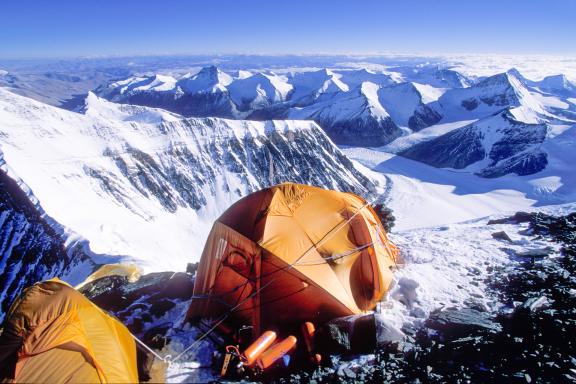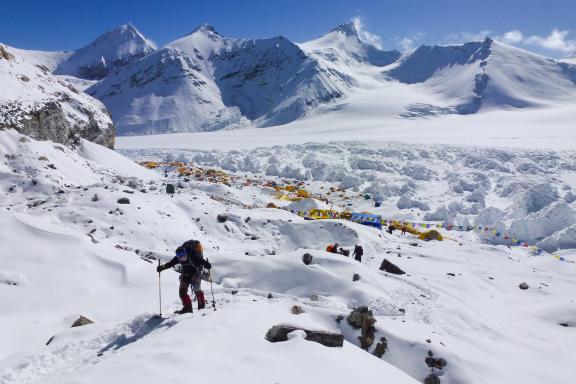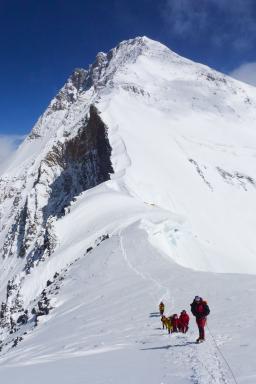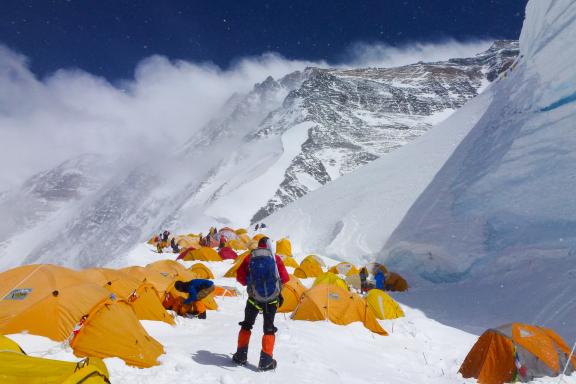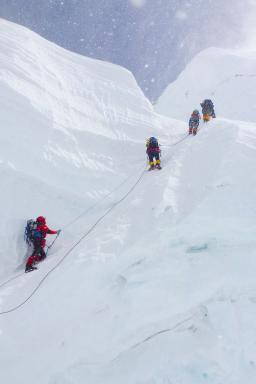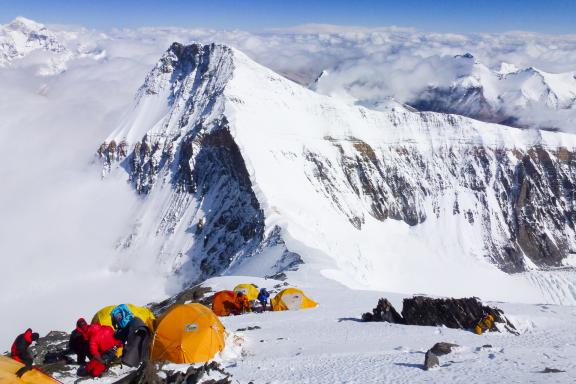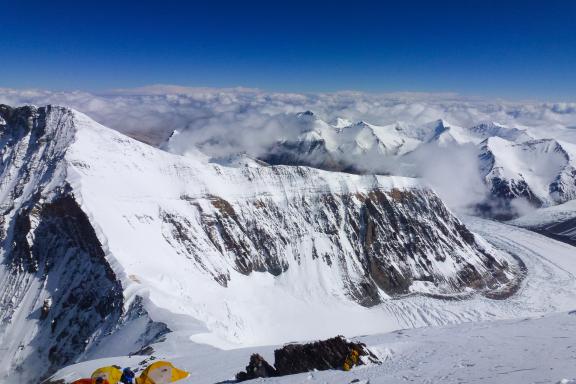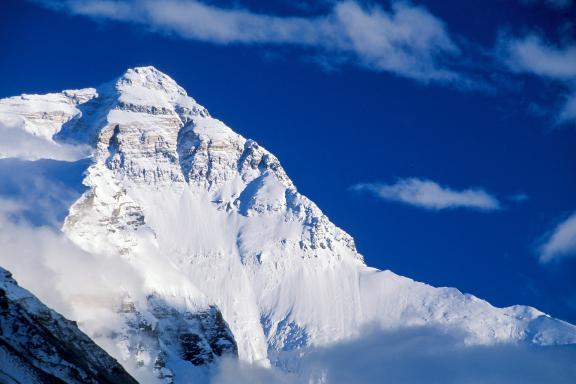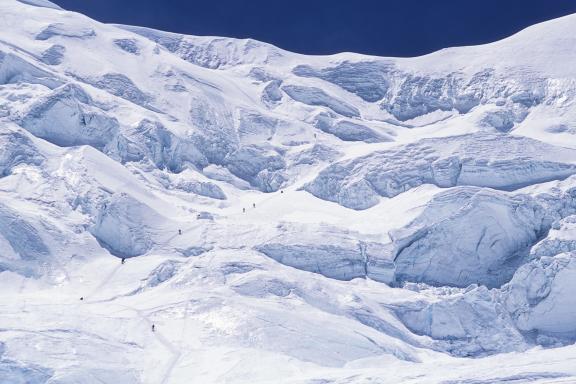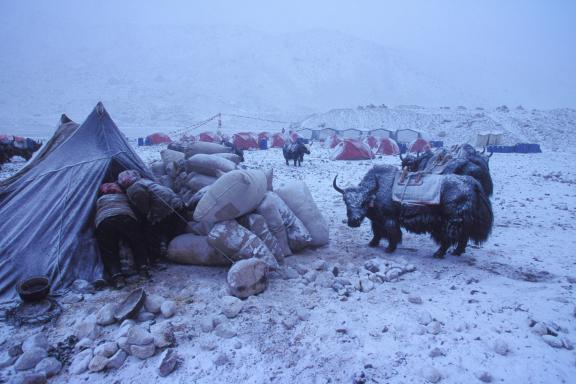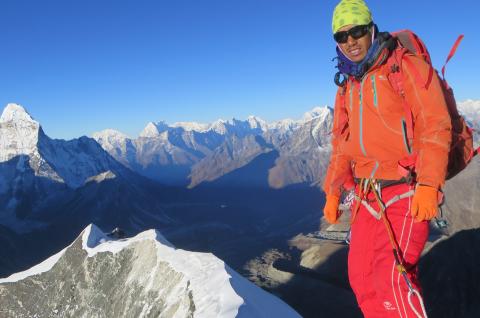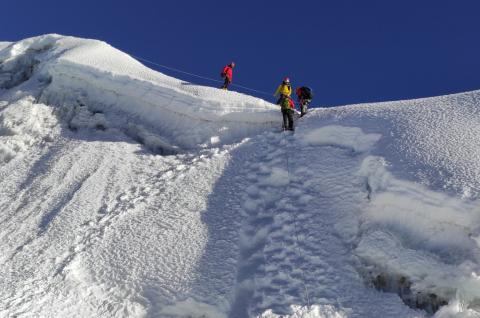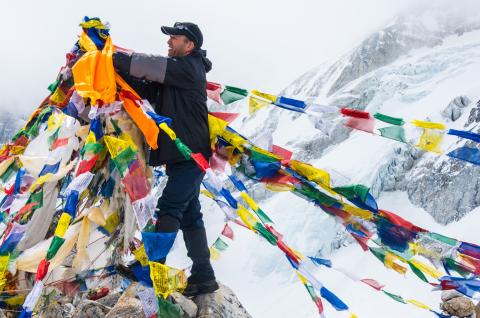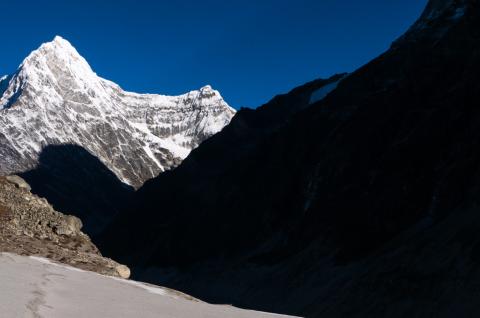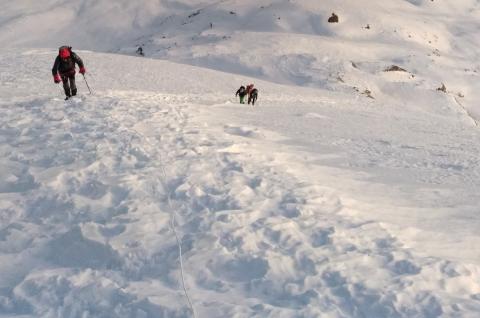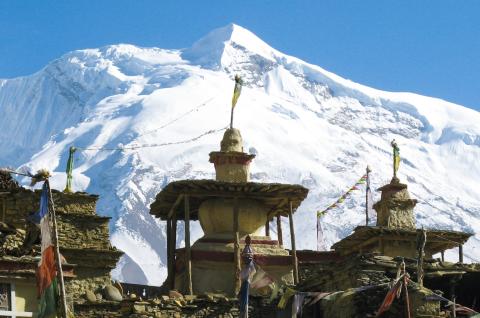Climbing the roof of the world on the more accessible side... The dream of a lifetime
Highlights
- Climbing the Tibetan North Face
- Objective hazards not as high as on the southern slope
- Ratio of 1 sherpa to 1 participant
- Experienced expedition leader
- Special care given to high-altitude food
- H24 personalized weather forecast services and medical hotline
- Preparation course, live expedition coverage
- Departure garanteed from the first participant
Here we set off on the ultimate expedition, the one many dream of completing: climbing the roof of the world via the Tibetan side, a mythical route on which the British launched no less than seven unsuccessful expeditions between 1921 and 1938. The scene of Mallory and Irvine's exploits and death. The very long ascent of the Rongbuk East Glacier brings us to the foot of the first difficulty: the ascent of the glacial slopes leading to the North Col (7000 m). Then comes the long climb up the north face to reach the north-east ridge at around 8000 meters. We still have to climb the first and second steps, the most difficult parts of the entire ascent. The route, technically easy, is subject to violent winds, including the dreaded jet stream, an altitude current capable of putting an end to the best climbers' progress. A major advantage over the "classic" south-facing route in Nepal: here, there is no Icefall to cross, but a very long, demanding route from start to finish. For many, the dream and achievement of a lifetime.
Overview
To ensure a trip in the best possible conditions, we concentrate our resources, strength and expertise on small teams. One of Nepal's most renowned mountain guides and UIAGM instructors assists you at base camp. A high-altitude sherpa accompanies you throughout the climb.
Our team is made up of cooks and high altitude sherpas with whom we work regularly. They are all experienced, qualified and government-approved. In addition to their efficiency and hard work, they have excellent interpersonal skills. We provide them with quality clothing and equipment, and insure them in accordance with Nepalese government regulations.
Our base camp is designed to be as comfortable as possible, with personal tents for participants, showers and toilets, a heated mess tent and solar power for lighting and charging your batteries.
We invite you to reread our two blog articles dedicated to the history of the conquest of Everest. :
The conquest of Everest: 50 years to reach the roof of the world - Part 1
The conquest of Everest: 50 years to the roof of the world - Part 2
And Bill Tilman: from Nanda Devi to Everest
Watch our video (in French) which presents the two Everest main ascent routes, South-East ridge via Nepal and Nord-Easy ridge via Tibet.
Check out our web-conference (in French) on climbing Everest and Manaslu.
MOUNTAINEERS' WORDS
"Strangely enough, I felt relieved, not so much by reaching the summit, but by the arrival of dawn at around 8600 meters. A long red line stretched eastwards towards Makalu. The day finally freed us from the weight of the night, from the strangeness of our cosmonaut progress on the edge of heaven and earth, and from the difficulty of the mind to grasp all the data of our ascent. When they joined me at the summit, I felt above all that I had been rewarded, along with Pierre, Thierry, Alain and Michel, for the interminable wait, for the difficult hours of waiting..., of constantly wanting to go back up and fulfill this dream of Everest." - Philippe Grenier October 9, 1992
"What is it that makes this summit so fascinating to all mountaineers?... It is the highest mountain in the world... The many expeditions, the men who have conquered it, have not succeeded in making it smaller... The altitude remains." – Reinhold Messner
"We didn't have to wait for the ultimate vision. Above the fog, Everest was still before us...: motionless as Keats's star in its solitary splendor, and so high in the night! Eternal watchman of the shadows, the Mount seemed to inebriate the world with its radiance." - George Leigh Mallory
"Suddenly, it occurred to me that the ridge in front of us, instead of continuing to rise, was falling sharply; much lower down, I could see the North Col and the Rongbuck Glacier; in the foreground, a narrow snow ridge climbed towards a snowy summit; a few more ice axe strokes in the hardened snow... and we were at the summit. It was 11:30 a.m." - Edmund Hillary May 29, 1953
COLLECTIVE ADVENTURE
While it remains an exceptional adventure, climbing Everest is no longer an extreme undertaking, reserved for a very high level alpine elite. Advances in logistics, mountaineering techniques and the general level of mountaineering skills now make the top of the world accessible to technically autonomous, well-trained and highly motivated mountaineers.
Our expedition will be a collective adventure, a confluence of motivations and energies, a meeting of the capacities of an organization and motivated climbers. Two parallel challenges will have to be met:
- for the participants: to be physically, technically and mentally at the top of their game at all times;
- for the organizer: to provide irreproachable logistics enabling access to the high altitude camps under optimum conditions. Beyond that, it is up to the participants to play their part, taking part independently in the assaults on the summit ridge led by the guide and sherpas.
The main objective of this expedition is to experience an adventure that requires total commitment, both physical and moral, acting with lucidity and humility in a hostile natural environment that forgives no imprudence or temerity leading to death. It is this testimony that must be wisely remembered.
Good observance of all safety rules is essential, as is good physical and psychological preparation, a warm and supportive environment, total serenity, a little tactics and then, if the weather is kind and luck is on your side, you will be able to count down the magic minutes at the summit when effort ceases and nothingness fills the space and instills itself within you.
It is agreed by all parties that giving up is never a failure, but that accepting it can also be a victory over oneself. Any preparation, even the most meticulous, any will, even the most tenacious, can be defeated by the adversity of natural environments whose force is exponentially stronger than the finest human intelligence. Let the gods bless us and allow us to tread the summit.
The motto is: dare to climb, know how to descend
VERY HIGH ALTITUDE
Advice from Hubert Giot, mountain guide. He has taken part in several expeditions to 8000 meters and climbed Everest without oxygen.
It is not easy to establish rules, because mountaineers are not equal when it comes to altitude, either physiologically or mentally. Everyone seems to have their own plateau where they get stuck. Extremely demanding, this stage is always painful, but not unmanageable. Once you are past this stage, everything is fine... or not so bad. It is generally at this point that you get a better idea of your ability to adapt. This can happen as early as 6000 meters, or even earlier, during the approach trek.
High altitude also has its own rules, and transgressing them becomes inherently dangerous. There is a fundamental difference between climbing to 8000 meters and descending immediately, and staying there for 12 or 24 hours.
At this altitude, the trouble really starts, and every minute spent up there leads to an inexorable process of self-destruction. We experience loss of sleep, lack of appetite, apathy and often hallucinatory phenomena.
In short... above 8000 meters, you are being consumed. For novices, anything is possible, just remember a few basic rules. The first few days at base camp serve as a thermometer, and by the third day you are often starting to feel good. It is then up to you to decide how to divide up the stages: either use the usual camp sites, or those defined by the terrain. As a general rule, when you can sleep at 6500 meters without headaches, you are ready to go higher. However, it is a good idea to make two return trips to 7000/7500 meters, to test your potential. During these essential shuttles, it is important to stay well hydrated. Now it is time to spend an often uncomfortable night at around 7500 meters, then attempt the summit at 8000 meters. If the summit is beyond that, we try to sleep at 8000.
As for the rest, you need to be prepared to use your brain (or what is left of it) rather than your muscles, because meters, beyond 8500 meters, are more costly. And if I say brain, it is because it has to be sufficiently alert to decide when to descend. If it does not, it is a sure death. Doing an 8000 in good conditions is hard, but with cold, wind, snow or a barometric depression, it turns into a nightmare.
As a general rule, here are a few precautions to take:
- don't get too cold ;
- don't get too hot ;
- cover your head ;
- stay hydrated, even in bad weather;
- try to have one hot snack a day;
- during the trek, do not walk bare-chested;
- at high altitudes, keep an eye on each other; don't doze off together;
- never descend alone;
- set limits for yourself, and look out for signs such as mirages, falling asleep and total loss of appetite;
- never hesitate to turn back, whatever the pressure;
- and in all cases, accept the fact that the mountains will always be there.
In short, to evolve at high altitude, you need meticulous preparation, adequate acclimatization, constant and mutual verification, intellectual vigilance at all times, and immediate renunciation in the event of weakness, doubt or danger.
CHRONOLOGY OF THE EVEREST CONQUEST
1920: First British reconnaissance on the Tibetan side, led by Colonel Howard-Bury. Discovery of the Rongbuk glaciers and the North Col. Georges Mallory's first encounter with Chomolungma.
1921 to 1938: Numerous attempts, always British, on the North-East Ridge. In 1924, Norton reaches 8580 meters without oxygen: he remains the world's highest man until 1952. Mallory and Irvine die at the same altitude.
1950 to 1951: Britain's elite mountaineering explorers, Harold Tilman and Eric Shipton, discover the approach and route of the Nepalese South Face, the Icefall and the West Combe.
May 29, 1953: After 30 years of unsuccessful attempts, the British finally reach the top of the world... thanks to New Zealander Edmund Hillary and Sherpa Tenzing Norgay, who inaugurate the normal route on the Nepalese side.
1975: The British open up the route again; Chris Bonnington's expedition attempts the south-west face of Everest, "the hard way". Doug Scott, Dougal Haston, Peter Boardman and Pertemba Sherpa solve one of the great Himalayan problems: bivouac without physical damage at 8760 meters...
1978: Reinhold Messner and Peter Habeler make the first ascent without oxygen.
1979: Hundredth ascent.
1980: Messner boosts his success by completing the first solo ascent of the North Face, without logistics or oxygen. First winter ascent by a very strong Polish team.
1985: Two hundredth ascent.
1990s: Everest becomes an "accessible" challenge, attempted with increasing regularity by numerous non-professional expeditions. At the same time, numerous records are regularly broken: record ascent time (Babu Tsering), number of ascents (12, by Babu Tsering Sherpa), night at the summit (Babu Tsering), paragliding from the summit, skiing down the South Face, surfing down the North Face... Five hundredth ascent.
2000s: Our world has changed, and Everest has become a commercial product, the subject of records and the object of great frequentation, following in the footsteps of record collector Steve Faucett. Initiatives marking an evolution in Himalayan climbing are taking place elsewhere.
The thousandth ascent in 2002, the two-thousandth in 2007. And some figures or special cases belong in the Guinness Book of Records. Married couples, brothers, fathers and sons, the handicapped, the blind, etc. have all reached the summit. In 2005, there was even a wedding at the summit. The youngest summiter is 16, the oldest 69. Appa Sherpa has made his sixteenth ascent. Pemba Dorjee Sherpa takes just over 8 hours to reach the summit from base camp.
By the end of the 2019 season, almost 7000 climbers had climbed Everest via the Nepalese South Face, of whom almost half were Nepalese sherpas, and less than 5% had done so without oxygen. To date, fewer than 500 women have climbed the roof of the world via this slope.
OUR APPROACH
TRUST, UNITY, SERENITY AND HUMILITY.
First of all, Everest is tamed through a great deal of prior reading, map consultation and listening to first-hand accounts, which allow us to familiarize ourselves with the mountain long before the expedition begins.
Preparation takes over a year. Various aspects such as physical training, mental preparation, thinking about what to do, and technical preparation are tackled with the utmost care.
To optimize our chances of success, in addition to top-quality high altitude sherpas, the most complete safety equipment has been organized, and oxygen will be used at night, starting from camp 3 at around 7300 meters. Initially at low flow, so as to be able to sleep properly, and at maximum flow during the summit push to make the effort more bearable.
The most appropriate food is provided, if possible to everyone's taste. For greater comfort and to enhance normal living conditions, a real camp will be set up at Camp 2, with a kitchen and permanent cook.
It is agreed by all parties that giving up does not in any way constitute failure. Returning to tell the story of your personal adventure can also be a victory over yourself. Any preparation, even the most meticulous, any will, even the most tenacious, can be defeated by the adversity of natural environments whose force is exponentially stronger than the finest human intelligence.
Let the gods bless us and allow us to tread the summit. That is why the best-trained sherpas make a point of devoutly presenting the offering to Sagarmatha, in a simple and moving ceremony as soon as we are settled in at base camp.
Itinerary
Day 0
We are going to attempt to climb the Tibetan side of Everest via the North Ridge, the scene of the first historic attempts.
After two days in Kathmandu for final preparations and formalities, we fly to Lhasa, 3650 metres above sea level. After a visit to Tibet's capital, we set off by 4x4 across the Tibetan highlands to reach base camp at 5200 meters.
This route is ideal for acclimatization, a crucial phase of the climb. From the fourth day of the trip, we combine altitude with a cultural visit to Lhasa, Tibet's mythical capital. Four days in a private vehicle then allow you to continue your acclimatization without too much effort, while discovering the vastness of Tibet.
Another more active acclimatization option would be to do a one-week round-trip trek to Kathmandu. This approach trek would allow you to acclimatize gently and gradually discover the environment of the Everest massif and the giants that surround it: Lhotse, Cho Oyu and Makalu... In itself, it is a fine route that could give some pleasure before the second part, the climb itself and its rigorous nature. We will decide on this approach in the final stretch of the expedition, in the six months leading up to it. The conditions, both in terms of duration and price, would not be modified. We would then take just two days to reach Everest Base Camp from Lhasa, where we would spend just one day.
DAYS 1 & 2: EUROPE — KATHMANDU
Day 1
Flight from Europe to Kathmandu. Arrival is usually on Day 2. Welcome by our local team at the hotel and free time.
DAYS 3 & 4: DAYS IN KATHMANDU
Day 3
A day dedicated to administrative formalities and preparation for the expedition. We take the opportunity to make our final purchases for the expedition.
DAY 5: KATHMANDU — LHASA
Day 5
We take off for Lhasa. This flight along the Himalayan range and over the Tibetan plateau allows us to admire the mythical mountains of eastern Nepal: Everest, Lhotse, Makalu, Kangchenjunga and Cho Oyu.
DAY 6: LHASA
Day 6
DAY 7: LHASA — SHIGATSE
Day 7
We set off by private vehicle across the Tibetan high plateaus to reach Shigatse, where we spend the night. We take the opportunity to visit the Tashilumpo monastery.
DAY 8: SHIGATSE — TINGRI
Day 8
This morning, we set off again for Tingri. The mountains are getting closer, and we arrive in Tingri at the foot of Everest and Cho Oyu.
DAY 9: ACCLIMATIZATION IN TINGRI
Day 9
We continue our acclimatization with a rest day in Tingri.
DAY 10 : TINGRI — EVEREST BASE CAMP (5 200 M)
Day 10
We climb to the famous Rongbuk monastery, facing Everest. The route takes us over a pass at 5200 meters above sea level, with exceptional views of five 8000-meter peaks: Makalu, Lhotse, Everest, Cho Oyu and Shisha Pangma! Rongbuk Monastery is a Tibetan Buddhist monastery at the foot of the Rongbuk glacier, 5100 metres above sea level, founded in 1902 by a lama of the Nyingmapa school. A few dozen monks live here. We then continue on to Everest Base Camp, which we reach in the early afternoon, at 5200 metres above sea level.
DAYS 11 TO 55: EVEREST CLIMB (8848 M)
Day 11 to 55
After several rest days and acclimatization at base camp, we depart for a two-day trek to reach Advanced Base Camp (ABC) at 6400 metres in altitude. We then alternate between rest phases, carrying to the upper camp and climbing to the last camp at 8250 metres. Throughout this period, the sherpas equip the mountain with fixed ropes, as well as the high camps.
Above the advanced base camp, we place a camp at the North Col or AC 1 Altitude Camp (7050 m), another, AC2 (7700 and 7800 m) and finally, a last one, AC3 (8250 m).
After a carrying up to Altitude Camp 2 (7700 m), we return to base camp (5200 m) for several rest days before attempting the summit.
A typical program might be as follows:
D12 - D18: ACCLIMATIZATION AT BASE CAMP (5200 M)
We spend around a week at the Chinese base camp, a genuine international tent camp where expeditions from all over the world gather. We trek around the camp and prepare the logistics, which will be brought up to the advanced base camp by our sherpas to set up camp.
D19 - D20: ASCENT TO ADVANCED BASE CAMP (6400 M)
It takes two days to reach the advanced base camp, where our yaks carry our packs and equipment. We arrive at ABC and set up camp.
D21 - D22: REST AND ACCLIMATIZATION AT ADVANCED BASE CAMP (6400 M)
D23: ASCENT AND OVERNIGHT AT NORTH COL OR AC1 (7000 M)
We ascend stony slopes equipped with fixed ropes that can exceed 30° inclination.
D24: RE-DESCENT TO ADVANCED BASE CAMP (6400 M)
D25 - D26 : REST AT ADVANCED BASE CAMP (6400 M)
D27: CLIMB AND OVERNIGHT AT NORTH PASS OR AC1 (7000 M)
D28: CLIMB AND OVERNIGHT AT AC2 (AROUND 7800 M)
We ascend a wide snow ridge equipped with fixed ropes and sections with inclines of over 35°.
D29: RE-DESCENT TO ADVANCED BASE CAMP (6400 M)
D30: REST AT ADVANCED BASE CAMP (6400 M)
D31: RE-DESCENT TO BASE CAMP (5200 M)
D32 - D33: REST IN A VILLAGE BELOW 4500 M TO RESTORE ENERGY LEVELS
D34: CLIMB TO BASE CAMP (5200 M)
D35: REST AT BASE CAMP (5200 M)
D36 - D37: CLIMB TO ADVANCED BASE CAMP (6400 M)
D38 - D42: REST AT ADVANCED BASE CAMP AND WAIT FOR WEATHER WINDOW (6400 M)
D43: CLIMB AND OVERNIGHT AT NORTH COL OR AC1 (7000 M)
D44: CLIMB AND OVERNIGHT AT AC2 (7700 M)
D45: CLIMB AND REST AT AC3 (8250 M)
From AC2, we cross several easy rocky ledges and a strip of snow to then go around the northeast shoulder. The ridge is equipped with fixed ropes all along.
DAY 46: EVEREST SUMMIT AND DESCENT (8848 M)
From Camp 3 to the summit, the ridge is about 1500 metres long and 450 metres in elevation gain. There are several rocky ledges, the first of which, just after Camp 3, passes under the ridge and is quite technical. Then comes the passage of the ladder at 8700 meters, left by the 1975 Chinese expedition and which will constitute the second step. In between, the ridge is sometimes a little airy. Then comes the summit pyramid, the last rocky passage, followed by snow slopes leading to the summit at an incline of around 45°.
From Camp 3, it takes at least 8 hours to reach the summit, and 5 hours to return. The descent presents no technical difficulties, but it is a tricky one given your state of weariness.
D47: OVERNIGHT AT ADVANCED BASE CAMP (6400 M)
D48: OVERNIGHT AT BASE CAMP (5200 M)
D49 - 55: CONTINGENCY DAYS FOR THE EXPEDITION
DAYS 56 & 57: TO KYRONG THEN KATHMANDU
Day 56
We return to our vehicles and head for Kyrong and then Kathmandu.
DAY 58: KATHMANDU
Day 58
DAY 59: RETURN TO EUROPE
Day 59
DAY 60: ARRIVAL IN FRANCE
Day 60
END OF EXPEDITION
If Tibet were to close down at the time of our expedition, as it has already happened on several occasions, we would not hesitate to change tack and attempt the ascent via the Nepalese route, whose major obstacle in the lower part of the itinerary remains its icefall. It is crossed by a network of ropes and ladders constantly moved by a specialized team of "ice doctors".
For reasons that cannot be foreseen at this stage, such as unpredictable weather, the fitness or lack of fitness of participants or others (customs formalities, road conditions, traffic, landslides, force majeure, etc.), your expedition leader may have to adapt the program, if necessary, to ensure the smooth running of your trip. He remains the sole judge and the one who guarantees your safety. Walking and climbing times are given as an indication and may vary from one participant to another.
The itinerary, and in particular the climbing schedule, is given here as a guide only, and is flexible enough to adapt to weather conditions with a few contingency days. In any case, you should follow the recommendations of your guide, who may suggest that you cancel your expedition due to weather, safety or physical condition.
It is important to remember that this is a truly unsupported expedition, and that anything can happen. Expeditions Unlimited, your expedition leader, your guide or our local teams can in no way be held responsible.
Likewise, the expedition can be stopped at any time if the guide judges it necessary, whether for the whole group or just a few participants.
Any costs incurred as a result of a change in the expedition schedule (extra nights' accommodation, extra flights) will be borne by the participants and not by the organizers. "Contingency days" refer to the expedition in the strict sense of the term (base camp/base camp in the mountains, departure point/exit point on a traverse, etc.).
Any early return of the expedition or of certain members only (early success, abandonment, etc.), generating costs for accommodation, meals, changes to air tickets or other activities not provided for in this program, will be charged in full to the participants.
Trip notes
Guiding
YOUR PRIVATE GUIDE
Key to your success on all our expeditions, we systematically use a ratio of one high altitude sherpa per participant. He accompanies you during the key moments of the ascent and during the summit push. He has taken part in several expeditions to heights of over 8000 meters, successfully leading participants to the summit.. We select him for you. He generally speaks English. He may not be with you all the time during rotations between camps, as his role is also to manage the carrying operations to set up the camps.
A summit bonus is also arranged for your high altitude sherpa, to be paid in cash on site after the ascent.
Our team of "altitude sherpas" can be made up of several Nepalese ethnic groups, Sherpa of course, but also Tamang, Gurung, Rai, Bothe, etc.
EXPEDITION LEADER
The expedition leader plays an important role in setting up the logistics of the upper camps and implementing the strategy required for success: rotation in the high altitude camps, acclimatization of each participant, study of weather reports to decide on the optimum moment to launch the summit push.
The expedition leader represents Expeditions Unlimited to the group, our partners and local authorities. Mainly based at base camp, he may accompany you to the high altitude camps to oversee the logistics of the expedition. He takes any necessary decisions. His authority is absolute and undeniable. You must respect his decisions, as well as those taken collectively.
From one to five participants, you have a local English-speaking expedition leader who has coordinated numerous expeditions over 8000 meters. He can be shared with other expeditions.
For groups of six or more participants, an experienced French expedition leader is assigned exclusively to your expedition.
LOCAL TEAM
For a project involving the ascent of a major Himalayan peak, our team is particularly well-staffed to deal as effectively as possible with the two key issues of an expedition: technical supervision and the carrying of equipment (food, collective and personal equipment). This is an important issue, as it directly affects the success of both parties. As a result of more than 10 years of joint reflection and work, our operation is fully optimized and the tasks entrusted to each person determine their own status.
We will have a local team with yaks to carry the equipment: 40 kg maximum, so make sure this weight is consistent with the equipment list from base camp to Advanced Base Camp.
A kitchen staff will be present at base camp.
There is a team of sherpas who help us set up base camp with all the equipment and cooking facilities. Beyond that, the team also help us to set up the high altitude camps and with the carrying from base camp.
Each participant is responsible for carrying his or her own personal belongings and high altitude food. Collective equipment is carried by the sherpa team. Our rucksack will weigh between 10 and 12 kg.
And throughout the program, we will rely on other local skills as needed. Finally, we will have access to personalized weather forecast services and a specialized high altitude doctor from Ifremmont (see above).
For unpredictable reasons at this stage, like adverse weather conditions, insufficient physical condition of participants, insufficient competencies of participants related to the intended activities, your guide may decide to adjust the intended program and/or activities. At all times, his decision will be final on all matters likely to affect the safety and well-being of the trip.
Difficulty level
Level rated: extreme
This program is intended for experienced participants, who have a high level athlete's physical and mental condition.
It is classified as an "Extremely Difficult" climb, given the very high altitude at which you will be working. Everest is the highest mountain in the world: although the technical difficulties are relative, climbing to the summit is nonetheless a difficult and sometimes even dangerous undertaking. Attempts to reach the summit involve a high degree of commitment.
This expedition is therefore designed for experienced mountaineers with a good knowledge of very high altitudes. It is essential to be totally self-sufficient in the mountains, both technically and psychologically. The expedition leader and guides are primarily technical advisors and logistics managers. Under no circumstances can they "pull" a participant towards the summit.
Rigorous training is of course essential, focusing on developing endurance and stamina: running, cycling, swimming, cross-country skiing and, of course, mountain climbing. This training must be regular and begin at least 6 to 8 months before the start of the expedition.
Preparation will continue to be carried out in constant liaison with the organizer and guide. Particular attention will be paid to safety and the management of high altitude hazards. Everest is first and foremost an adventure to come back from and bear witness to.
And it is a pleasure to quote Eric Shipton, who was left out of the British success story of 1953: "To what extent does the pleasure of mountaineering lie in the experience of attempts? To what extent does it depend on the laurels of glory? Those who eventually reach the summit of Everest will never know the mountain as Mallory knew it."
High altitude is, of course, the major problem we face. The process of oxygen deficiency (hypoxia) is at its peak when climbing a peak such as Everest. Progressive acclimatization is essential to offset this phenomenon as much as possible. During the first few weeks, you need to take it easy, avoid violent efforts and go at your own pace. Although "secondary" symptoms such as migraines and nausea are virtually unavoidable in the early stages, be careful not to ignore them, as they can trigger an oedematous process.
For a relatively long period of time, the body will be subjected to considerable physical effort in a difficult environment, with the added handicap of high altitude. Serious physical preparation is essential for an expedition of this scale: you will need to work on your stamina and endurance, even in difficult climatic conditions (cold, wind).
Beware of carrying: while collective equipment is carried by the sherpas, personal belongings must be carried during the ascent; not doing so at all would be highly detrimental to summit attempts, during which a bag of some weight must be carried, since it will have to contain oxygen cylinders.
On an expedition, participants are confronted with a hostile environment due to its remoteness, cold, bad weather and discomfort, all of which can generate stress. Fatigue can be the cause of mood and relationship disorders. Everyone must therefore show good mood, tolerance and respect, not only towards the members of the expedition, but also towards the local team. The group may split into sub-groups according to individual affinities. Keep in mind that it is the core team that prevails and that, as always in this type of project, the key to success remains the collective and team spirit.
Therefore, participation in the preparation course, the date of which will be specified later, is mandatory. In addition, mountaineering preparation courses as part of our Adventure School can be a serious asset, both to build confidence and to gain autonomy.
To register for this expedition, you will be asked to provide an expedition (mountain climb list)/trek/athlete CV. A hypoxic stress medical test is also mandatory, as is a medical certificate for completing an ascent in the Himalayas.
You benefit, free of charge and for the duration of your expedition, from membership in the 24/7 high altitude medical service set up with our partner Ifremmont, of which we are partners. See below.
If you have any health problems that you feel could compromise the success of your expedition, please let us know so that we can assess together whether they are compatible with this expedition. And we strongly advise you to have a check-up with your dentist before departure, given the length of the expedition and the significant variations in altitude and pressure.
Last but not least, we can provide you with a sports coach and/or a mental coach for the months leading up to your expedition, to help you prepare in the best possible conditions. We have developed remote protocols in this field, just as we have built a hypoxia preparation protocol which we describe later in this document in the chapter devoted to Ifremmont.
In the longer term, we offer refresher and advanced mountaineering courses as part of our Adventure School, as well as expeditions to peaks at 5000, 6000 and 7000 meters, offering you the ideal progression towards your dream goal at very high altitude.
Technical difficulty
Mountaineering level: Not very difficult (PD)
In this program, the use of mountaineering equipment (crampons, harness, ice axe, ropes, etc.) is necessary, and the route tackled may involve minor difficulties, whether it be slightly steeper passages during glacier mountaineering, the height of the wall, the commitment of the run or the continuity of effort. Of course, altitude makes everything more difficult. Steep or more arduous passages are all equipped with fixed ropes, so you need to be comfortable with a self-locking handle in all situations. This climb is aimed at participants with previous mountaineering experience and who have already completed climbs of this level.
This technical rating applies, of course, to normal weather conditions: difficulty can increase in poor conditions, with fresh snow for a rocky route, insufficient or poor-quality ice for glacier mountaineering, etc., and the situation can change radically if the weather is not too bad. Similarly, the situation changes radically, for the same technical level, with altitude, the weight of the rucksack, the lack of equipment for the route on site, the fatigue linked to the approach if it is long, the particularly hostile environment, and so on.
Our École de l'Aventure's three-to five-day mountaineering courses are designed for you, and are the perfect way to make sure you are at the right level.
Meeting point
The flight from Kathmandu to Lhasa is included in this package.
Given the diverse origins of the participants on this trip, international outward and return flights are not included in this package. In most cases, we book flights on your behalf to ensure that the whole group arrives at the destination at the same time. We do not charge any fees for these air bookings. Please do not hesitate to contact us. If you book your own tickets, we will advise you on the ideal flight schedule to enable all participants to arrive within a reduced time frame. At the very least, you need tickets that can be modified.
Accommodations
KATHMANDU AND LHASA
In a single room in a 3/4* hotel in Kathmandu and Lhasa.
SHIGATSE, NEW TINGRI AND GYRONG
Single rooms in local hotels, subject to availability.
BASE CAMP
At base camp, we stay in individual tents.
As a base for several weeks, it needs to be as comfortable as possible, to enable us to recover properly on our return from the altitude camps. It should also enable us to cope with periods of bad weather in the best possible conditions. Each participant has his or her own individual tent with a comfortable mattress. A heated mess tent is the main living area. Tables and chairs are permanently installed. We also have a shower tent and a toilet tent (solid waste is disposed of in drums).
HIGH ALTITUDE CAMPS
During the ascent, at the altitude camps, we have an altitude tent for 2 people, and even 3 people at the last camps.
Hygiene & laundry
Toilets: The base camp is equipped with toilets and toilet paper. Make sure you wash your hands with a hydro-alcoholic gel (available from your personal pharmacy) after each use of the toilet. For the higher camps, we recommend that you take a bottle with you to urinate in at night, to avoid having to go outside.
Daily hygiene: a basin with soap and water is available at the entrance of the mess tent. Water for washing hands and face; do not drink.
Showers: hot water available (request from kitchen). Showers should only be taken on sunny days to avoid catching cold!
Laundry: (cold) water and basin to be requested from the kitchen. Bring biodegradable products only.
Meals
KATHMANDU AND LHASA
On arrival in Kathmandu, a welcome dinner is offered on the first evening. Similarly, on your return from the expedition, a farewell meal is provided. In Lhasa, there are many Chinese and Tibetan restaurants to choose from.
SHIGATSE, NEW TINGRI ET GYRONG
Meals at hotels where we stay.
BASE CAMP
All meals are prepared by the kitchen staff using local ingredients, including rice, pasta, lentils, potatoes, vegetables, eggs, a little meat, etc. They are served in a private tent. Hot non-alcoholic beverages such as tea and coffee are provided free of charge. We recommend that you stay hydrated at all times.
HIGH ALTITUDE CAMPS
At altitude, you often have to force yourself to eat. The use of freeze-dried food is almost unavoidable. But such dishes, appetizing in the valley, quickly become a source of disgust in high altitude camps. During the preparation course, we bring a sample of lyophilized dishes for you to taste, to indicate your preferences, which we do our utmost to respect (depending on the stocks available at the time of final purchase). You can also bring along a few of your favorite dishes (if you have any). For your comfort and the pleasure of tasting, we have included a few "delicacies" from France (savoury and sweet).
Each tent has a stove for melting snow (MSR Reactor type) and making water for freeze-dried food and hot drinks. The necessary gas cartridges are supplied.
HYDRATION
Take along tablets (such as Hydroclonazone, Micropur or others) to disinfect the water you put in your water bottle, depending on the source and on the advice of your guide. It is sometimes possible to buy purified water and fill your bottle without having to buy bottled water. You can also buy "mineral" water in the towns (not included in the price), but as you know, it has a poor environmental performance. So we do not recommend it.
Besides, glacier meltwater contains no mineral salts, which is partly compensated for by the soups and other meals you will be eating. But if you only drink tea or coffee made from glacier meltwater, or just water in your water bottles, over a long expedition, youwill hydrate less well, risk gastric problems and, ultimately, deficiencies that will tire the body. To counter this problem, it is a good idea to pack mineral tablets in your luggage at some point, to supplement your water bottle. Two or three tubes of ten tablets are all you need.
Transfers / Transport
Transfers to and from the airport are by minibus. The return journey between New Tingri and Kathmandu is by 4x4 or minibus.
Group size
The group is composed of 1 to 10 participants maximum. The number of participants is deliberately limited to allow for greater immersion, to avoid embarrassing our hosts, and to develop freedom and flexibility. However, the maximum number may be exceeded if the last person to register wishes to travel with one or more other people. The services will not be modified, and the conditions of the trip will remain the same.
Equipment
COLLECTIVE EQUIPMENT
All logistical equipment is provided, including individual tents at base camp with mattresses, mess tent, shower tent and toilet tent, as well as all collective and individual cooking equipment. At altitude, tents, stoves with gas cartridges, ropes and anchors.
INDIVIDUAL EQUIPEMENT
Personal equipment is not provided. A full list is given later in this document. It will be refined with us during the preparation course and up to the moment of departure, depending on your questions.
High altitude sleeping bags, full-body down suits and/or good-quality down jackets are expensive items that you may not use frequently. We can rent you this specific equipment for the duration of the expedition. You must then return the equipment cleaned and in the condition in which it was given to you (deposit required). The rental price will be communicated to you on request. The cost of transport remains your responsibility, unless you pick it up at the agency in Lyon.
OXYGEN OR NO OXYGEN
For safety's sake, high altitude sherpas always use oxygen, even at reduced flow rates.
The vast majority of participants in all Everest expeditions on the Tibetan side take oxygen from Camp 2 (7700 m), and some as early as Camp 1 (7000 m). We therefore include in your package the oxygen supply from Camp 2 (6 cylinders, regulator and oxygen mask). The cylinders and the equipment needed to use them are transported to the altitude camps by the altitude porters.
If you wish to use additional oxygen before Camp 2, you will need to ask your expedition leader and/or sherpa as soon as possible during your expedition, and additional cylinders will be charged extra. Oxygen cylinders not included in the package must be paid for on site.
That said, we are one of the few organizers to allow our participants to attempt the summit without supplemental oxygen. Our experience shows, however, that only the most experienced Himalayan climbers manage to achieve this feat (between 1 and 2% success rate every year). The organization, and in particular the ratio of "1 high altitude sherpa to 1 participant", means that the pace of ascent can be slightly different and more personalized. So we can have participants in the same group who need oxygen and others who do not.
If you choose to attempt the climb without the use of oxygen beyond Camp 2, then you need to talk to us as soon as possible to fine-tune your acclimatization. Your choice will depend on the agreement of your expedition leader and/or your sherpa, who will assess your fitness during the first rotations. Please note that if you choose not to use supplemental oxygen for your ascent, no refund will be given. For safety reasons, one oxygen cylinder per participant is provided at Camp 4, whether you use it or not.
You then have two options, starting from Camp 2 (7700 m) during the summit push:
- You do not need an oxygen cylinder: the "purist" option par excellence. It allows you to move forward without adding extra weight (4/5 kg). But if you become too tired or slow, you have no option but to turn back, whether your sherpa tells you to or not, and return to Camp 2. The summit attempt is over, there will be no more.
- You take at least one oxygen bottle with you if you need it to complete the climb: it means extra weight in your rucksack (4/5 kg), and it is up to you to use it or not, at any point during the summit push.
SECURITY AND COMMUNICATION
We have a minimum of one Iridium satellite phone for the group, which is used for logistical, weather and safety purposes only. Under certain conditions, participants may make use of it. For private use, please contact us.
The camps will be permanently linked by radio. Expedition leader, participants and high altitude sherpas will also be able to use them.
The expedition will have a hyperbaric chamber at base camp, and a full pharmacy, though lighter, at the upper camps.
The group will be equipped with a Garmin Inreach beacon, enabling you to communicate freely and without restriction with your friends and family, wherever you may be on the mountain, as well as sending tracking and safety information. It is on this beacon that you will receive weather forecasts and that we will communicate together regularly.
At the same time, we will provide live coverage of the expedition for the general public, including a logbook and photographs, enabling you to share your adventure with your community. To this end, and if the base camp is not equipped with wifi or 4G, you can also use an IridiumGo system to send your photos. These systems are simple to use, but require a few tests before departure, which we will carry out together.
In addition, at the time of writing, all participants are free to bring any systems they have. We just need to be able to declare them to our contacts, so please let us know in advance.
Please note: in order to preserve the serenity of this expedition and the privacy of the participants, we ask you not to communicate with the general public during the expedition. You are, however, free to send information about yourself to your private sphere. By registering for this program, you accept this essential clause to protect the privacy of other participants in a project of this scale, where important issues of image, physical risk and financial considerations (sponsors, etc.) are at stake.
Our commitments to sustainable development
Our commitment to a better planet has been a reality since the beginning of our story but we always need to do more and better. Please find out more about our charter and our commitments in terms of sustainable development. We have drafted our charter and take action through six themes on which we act as concretely as possible, most often with you: social equity and cultural respect, preservation of water, waste management in expedition, protection of biodiversity, raise public awareness on these subjects and finally, the optimization and recovery of CO2 emissions.
Regarding carbon emissions, most of which are due to air travel, we calculated and communicated in 2018 on the carbon footprint of each of our programs, expressed in tonnes of CO2.
These calculations made us aware of the importance of the total carbon emissions generated by our activity. Also, we have committed in 2022 to a carbon reduction that we believe is unprecedented in the tourism industry, aiming to reduce the total emissions of our activity by 5% per year, taking 2019 as the reference year (3,430 tonnes of CO2). This commitment is in line with the trajectory of the Paris climate agreements of 2015, the current benchmark. Thus, in 2030, we commit ourselves not to exceed 2,160 tonnes of C02. Thus, our maximum “carbon” budget for 2024 is 2,950 tonnes and for 2025, this budget will be reduced to 2,800 tonnes. And so on until 2030. To find out more about all of our calculations and our commitments in terms of reducing our carbon emissions.
In addition, since 2019, we have been encouraging you when you book for your journey to contribute with a donation to an independent NGO, among the two we have selected that share the commitments made in our charter. We matched the amount of this donation to this program's carbon footprint. Thus, the journey you are considering generates 4,21 tons of CO2, which corresponds to a 100% donation of €126 for an estimated value today of €30 per tonne of CO2. This donation remains of course optional and you can decide to give between nothing and 100% of this amount. Since 2019, including covid years of 2020 and 2021, we have been able to collect thanks to you nearly €7,000 for these associations.
Please do not hesitate to come back to us with any questions you might have regarding this carbon footprint mechanism, our other sustainable développement commitments or even to share with us your experience through a chat or a mail at contact@secret-planet.com.
Expedition leader
We rely on the most experienced high altitude expedition leaders. They are part of our close community and co-opt each other. They know each other well and respect each other.
For this expedition, the expedition leader has not yet been formally appointed, but should be shortly.
In addition to their exceptional expeditions experience, our expedition leaders have the know-how to optimize the expedition's chances of success, both in terms of group management and in terms of the pace at which the group builds up its strength and progresses in altitude, key elements in this type of expedition.
Departures and pricing
Please find below all dates and prices for this expedition. Prices are quoted "from" and may be adjusted notably according to the number of participants (see trip notes for details). Please note that dates and prices for years beyond 2024, when given, are for guidance only and are subject to change and readjustment to take account of current economic realities.
No date works for me!
I initiate a new datePrice includes
- Flight Kathmandu - Lhasa
- 3/4-star (***) hotel accommodation in Kathmandu and Lhasa with breakfast, double room for five nights
- Hotel accommodation in double room with breakfast in Shigatse, New Tingri and Gyrong
- Welcome dinner on arrival in Kathmandu
- Meals as mentioned in the program
- Guided tour of Lhasa and transfers
- Tibet visa and Everest climbing permit
- Transport of your personal equipment between Kathmandu and the advanced base camp, based on 40 kg per person
- Equipment required for life at the advanced base camp: fully-equipped kitchen tent, mess tent for meals, toilet tent, shower tent, table and chairs.
- Cook and helpers
- Experienced French mountain guide from 6 participants
- 1 local altitude guide for every 1 participant: he carries food and equipment to the high camps and assists you on the final ascent
- Transfer of staff, food and collective equipment between Kathmandu and base camp, then to advanced base camp and back
- Local cook at base camp and advanced base camp
- Experienced local expedition leader (sirdar) at base camp and advanced base camp
- 6 oxygen cylinders with mask and regulator per participant
- 4 oxygen cylinders with mask and regulator per altitude guide
- Insurance for local altitude guides (evacuation, hospitalization, medical expenses, life insurance), for the cook and his helpers, and for the Chinese liaison officer
- Individual tent, insulation mat, mattress and pillow per participant at base camp and advanced base camp
- Altitude tents, altitude food, stoves and fuel
- Dome tent with table, chairs, heating and lighting at base camp and advanced base camp
- Fully equipped kitchen tent, mess tent for meals, toilet tent, shower tent, table and chairs
- Collective equipment required for ascent (fixed ropes, moorings, etc.) and set-up fees for CTMA collective teams
- 1 walkie-talkie for every 1 altitude guide, in connection with base camp and advanced base camp
- Equipment allowance, fees, tent and food for cook and helpers, and for Chinese liaison officer
- 1 satellite telephone at advanced base camp (for rescue purposes only)
- Electricity at base camp for powering laptops, smartphones, amateur cameras and videos
- Internet/Wifi access at base camp
- Solar panels at advanced base camp for small equipment only
- Rope fixing fee and all government environmental taxes and garbage deposit.
- Personalized weather forecast services
- Preparation courses (practical, medical)
- Medical follow-up by Ifremmont during the expedition (see above)
- Live expedition coverage for your community (supply of InReach beacon, IridiumGo and subscriptions, LivExplorer service configuration)
Price does not include
- International return flights Kathmandu
- Hotels and meals mentioned as "not included" in the detailed program
- Personal equipment including individual high altitude gear
- Rental of personal high altitude equipment, subject to availability
- Additional oxygen cylinders (approx. US$650 to be paid locally)
- Personal satellite phone calls (to be paid locally, approx. US$3/minute)
- Drinks and personal expenses (sightseeing, cabs, souvenirs, dry-cleaning, etc.)
- Travel and expedition insurance (assistance and repatriation)
- Expenses related to the early return of the expedition or of certain members only (early success, abandonment, etc.), generating costs for accommodation, meals, changes to air tickets or other activities not provided for in this program
- Expenses related to a shift in the expedition schedule (extra nights' accommodation and meals, additional airfares)
- US$2,000 summit bonus for your altitude guide, to be paid on site after the ascent
- Tips for local team, 400 US$/participant
- Excess baggage for the Kathmandu/Lhasa flight: on this flight, you are entitled to one checked luggage item weighing 23 kg and one cabin luggage item weighing 7 kg. For each additional kilo, you will be required to pay a local fee of US$7/kilo/journey
- Import permits for electronic equipment regulated in China, in particular satellite telephones (US$500), communications and image equipment (up to US$30,0000 to be paid to CTMA)
- Customs duties on arrival in Nepal for specific equipment or other items
Your custom expedition
We put our expertise, our knowledge of the terrain, our creativity, our experience, the quality of our guides and the reliability of our partners at your service to build your custom expedition. We can also personalize an expedition to your wishes as soon as you form a "closed" group, whatever the number of participants.
This means that, unless you authorize us to do otherwise, no outside participants join you, and we can personalize your expedition by adapting it to your own pace, with the program extensions you desire, a higher level of comfort, certain activities, other encounters, etc.
Every expedition of this type is subject to a specific quotation. To get in touch with us now, please fill in the short questionnaire below. One of our experts will get back to you to refine your request and make you a proposal.
